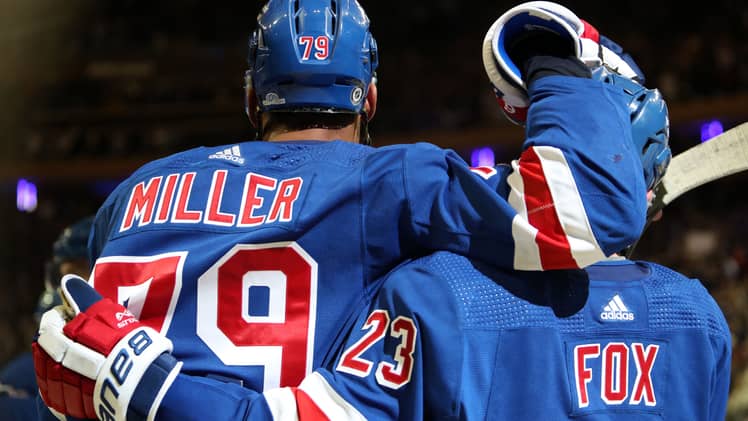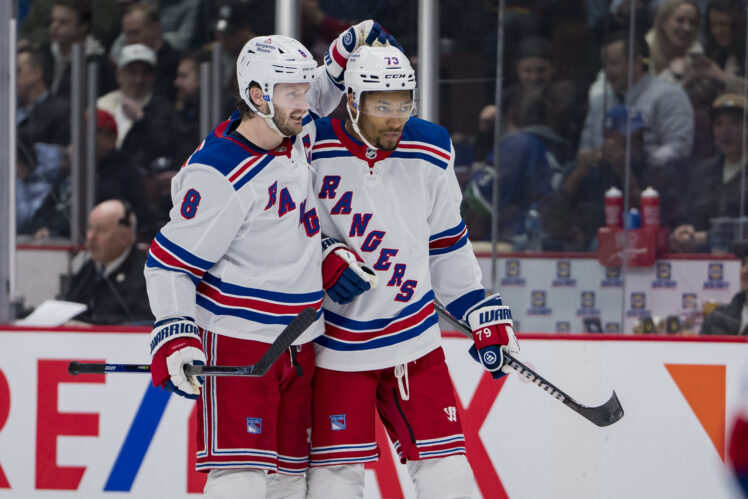New York Rangers defense will thrive in Peter Laviolette’s system

There’s been a lot of buzz around the New York Rangers focused on Peter Laviolette and his system.
At one point, there were so many questions regarding it, that Laviolette joked if every previous Rangers’ coach was required to give their system to the NY Post.
When the Rangers decided to part ways with Gerard Gallant after a disappointing first-round playoff loss, rumblings around the organization were that he did not have a system in place to deal with the speed of the New Jersey Devils. His lack of adjustments was another issue that led to a new bench boss after back-to-back 100+ point seasons.
Now, as the 2023-2024 campaign approaches, the Blueshirts are currently learning a new style and structure under Laviolette. His reputation as a coach in the NHL is one that favors aggressive, fast-paced hockey that efficiently combines both forwards and defensemen into scoring opportunities.
The new coach is also open to many things, including trying new pairings that may see Adam Fox separated from his long time partner, Ryan Lindgren.
“I understand the philosophy of having a good, anchoring defensemen with an offensive-defensemen to push the offense, but I think there’s times where you have your top line in the offensive zone, and you want to put out two guys that think more offense,” Laviolette divulged. “Conversely, you might be in the defensive zone and want a couple of guys who think more defense.”
Regardless of what duos Laviolette lands on, the Rangers defense will greatly benefit from these changes.
Related: Vets embracing Peter Laviolette as coach
New York Rangers defense should thrive under Laviolette

Fast Transition Game
The quick transition game is one of Laviolette’s trademarks. Defensemen playing in his system must be ready to advance the puck fast. To be successful, crisp first passes out of the defensive zone are essential, as well as having awareness of when to join the attack. In this aggressive style, the risk of turnovers may increase, so defensemen must be cautious with the puck.
Defensemen like Adam Fox and K’Andre Miller, who like to transport the puck should thrive. That being said, everyone else needs to be quick in transition, especially making that first pass out of the zone.
Offensive Zone
Laviolette advocates for his defensemen to be active in the offensive zone. Therefore, defensemen are going to be asked to pinch at the blue line, join in on the rush, and on some occasions, cycle down low. Others may be asked to find lanes and fire pucks at the net for deflections and rebound chances, while players with an effective shot from the point will be given the green light to shoot often.
“The sense of direction I think is good for us,” captain Jacob Trouba said. “Already in the first practice, we’re going over offensive zone ideas. We went through systems up and down the ice with video. [The players] have to implement it, but he’s given us the tools to be successful this year.”
This all has to be music to Fox’s ears as he inches closer to being a point-a-game defenseman. The 25 year-old recorded 72 points in 82 games last season and was nominated for the Norris Trophy.
Neutral Zone
Tight neutral zone play is one of the main concepts of Laviolette’s system, something that the Rangers have struggled with in years past. The neutral zone is important because it often impacts the game’s tempo and which team will have control in the offensive zone.
“I’d like to be aggressive in the neutral zone when we can and I like to force the issue,” Laviolette admitted. “There’s no sense in losing guys and pushing players up the ice when we go into a certain neutral-zone defense. I’ve been doing it for a long time and the thing that’s a little difficult to pick up inside the system because there’s some positioning that goes with that.”
Teams under Laviolette typically use a 1-3-1 style forecheck. The first forward pressures the puck carrier in this system, while the other three forwards hold back, hoping to intercept passes or apply pressure to the opposition once the first forward has been beaten. To defend against potential breakouts, the lone defenseman stays back towards the blue line.
Another added benefit should be standing up on the blueline and giving the opposition resistance to gain the zone. This has been a point of contention for many when it comes to the Rangers defense.
If the Rangers can get this down before the start of the season, it will not only benefit the defensemen, but the team’s best offensive forwards as well.
Defensive Zone
While the defensive zone’s primary structure can sometimes be zone-based, Laviolette’s doesn’t appear to be. One thing is clear, there’ll be a emphasis on each player’s responsibilities. Particularly in high-danger situations, defenders will need to identify and stay with opponents. In these scenarios, communication between defensive partners and with the goalie becomes crucial.
“It’s a lock (system), where you are hanging back a little bit more,” Schneider explained. “It’s going to be some time to get used to it.”
What Schneider is referring to, is likely a variation on the left wing lock deployed by such coaching greats as Scotty Bowman. This requires a forward, to come down with the defense to force a turnover. A much welcome change for a team that’s given up far too many scoring opportunities in the slot over the years.
This should greatly benefit Ryan Lindgren and Jacob Trouba, who like to throw hits which can sometimes put them out of position.
K’Andre Miller, who is entering his fourth NHL season with his third head coach, discussed the changes he’s made so far in the defensive zone under Laviolette.
“The biggest thing I guess in the D-zone for me is staying a little bit tighter, staying close to the net, with everybody more compact so you have that little bit more comfortability with support and moving pucks to guys who are maybe five-feet away instead of seven, eight-feet away from you up the wall,” he said. “So that’s probably the biggest thing, the comfortability of feeling where everybody is and supposed to be.”
Special Teams
Defensemen with strong offensive instincts and skill will get an opportunity on the power play given Laviolette’s offensive-focused strategy. On the flip side, defensemen will need to block shots, minimize shooting lanes, and make quick decisions to get the puck out of the zone while the team is on the penalty kill.
Players who already have offensive upside may benefit from a Laviolette system given the Rangers’ young and energetic defensive core. A system that gives defensemen greater latitude to join the offense may be beneficial to the success of players like Fox, Miller, and others. The Rangers’ youth and quickness may also complement Laviolette’s fast-paced style.
“They’ve been breaking down video for us very well, which is huge, obviously, with new coaches, new systems, a little bit different style,” Miller noted. “You just try to get familiar with that, asking as many questions as you can and gather as much information as you can.”
From the first week of training camp, it sure looks like the Rangers’ defensive core will embrace a mix of freedom and accountability in Laviolette’s new system. While there will undoubtedly be mistakes made along the way, there will also be huge rewards that will make watching Rangers games even more exciting.
More About:New York Rangers Analysis New York Rangers News
